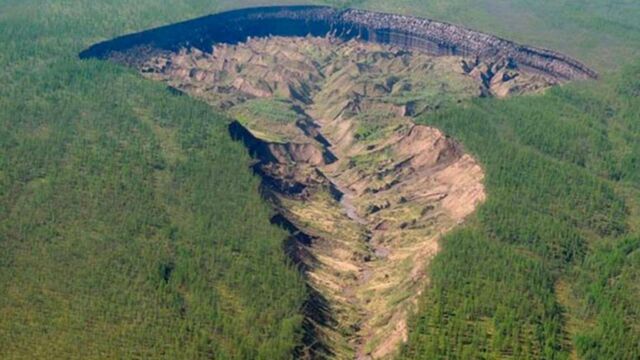Locals have nicknamed it the ‘gate to hell’ and with just one look at the images you will understand why. To the east of Siberia in Russia, near the Yana River Basin, the land seems to have split in two, forming a giant crater in the middle of the forest, known now as the Batagaika crater.
Discover our latest podcast
This vacuum was created due to a phenomenon called Thermokarst. It is caused by permafrost (permanently frozen ground) melting. This meltingcauses instability in the ground which then leads to a collapse. According to specialists, the Batagaika crater started to form in the 1960s due to deforestation in which the trees that used to protect the ground from the heat during the summer months were removed.
Currently, the giant crater measures almost a kilometre long by 86 metres deep, making it one of the largest in the world. Nevertheless, there is now constant surveillance on the crater after satellite images have revealed that it is still growing at a concerning rate.
The crater that gets bigger each year
In December 2016, German researchers at the American Geophysical Union explained that the crater’s main wall grew by 10 metres each year over the last decade. During the hottest years, this rate increased to 30 metres a year. The team also believes that one of the side walls of the crater could soon reach a nearby valley that has already eroded.
Frank Günther from the Alfred Wegener Institute in Potsdam said to the BBC:
On average over many years, we have seen that there’s not so much acceleration or deceleration of these rates, it’s continuously growing and continuous growth means that the crater gets deeper and deeper every year.
For scientists, the melting of permafrost sped up by climate change is a cause for major concern. But this isn’t just observed in the Siberia region as other smaller vacuums have also been found in other areas.
However, the permafrost melting could have serious consequences for the environment, such as greenhouse gases escaping, particularly carbon dioxide, that will have been trapped for millions of years in the ice. Gases like these could speed up global warming even more. However, the Batagaika crater is also very interesting for a different reason.
Over the last few decades, the growth of the crater has actually brought to the surface a world that was once inaccessible because it was frozen below the ground. The site has become one of the most significant in the world for studying permafrost, but also for studying thousands of years of history as highlighted by the new study that was published in the Quaternary Research journal.
A window into the unknown world
In 2009, an old horse carcass from around 4,400 years ago was discovered there, as well as a mummified carcass of a young buffalo. Precious items as well as other things such as mammoths and reindeer have also been found here. A recent expedition has however led to even more remarkable discoveries.
When they visited the site, British scientists saw many very old geological layers and managed to collect samples of the ground and the vegetation. Analysis suggests that these samples could be more than 200,000 years old, which could determine what types of forest and ground existed in this area, and it doesn’t stop there.
Batagaika itself struck my imagination – its size is amazing the crack itself is perfectly exposed, uncovered, all the layers are perfectly visible and can be thoroughly studied.
Over the last 200,000 years, Earth’s climate has repeatedly alternated between relatively hot ‘interglacial’ periods and very cold ‘glacial’ periods during which the ice gained ground. But climatic history in Siberia is still relatively unknown, hence the interest in the Batagaika crater.
Sedimentary layers at Batagaika provide a ‘continuous record of geological history, which is fairly unusual,’ confirmed Julian Morton who then added that scientists should be able to interpret the climate and environmental history there by analysing the layers. By recreating these past changes, researchers believe that they will be able to understand future changes. The scientist concluded:
If we can understand what the ecosystem was like then – that might give us some inkling into how the environment may change now if the climate is warming.















